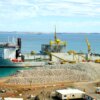“Facts About Subsea Rock Installation” describes techniques being used for rock placement to protect marine infrastructure, especially for offshore energy.
Two types of subsea rock installation can be distinguished:
- One is for shallow water and is typically used for coastal and embankment protection works and for scour protection for the offshore oil, gas and wind energy developments at up to 50 metres of water depths.
- The other is rock installation at greater water depths, usually ranging from 50 to 2,200 metres, and is most frequently applied for the offshore oil and gas industry.
For the first, a technique known as “side-stone dumping” is utilised. These are vessels, usually self-propelled, with reinforced, strengthened flat decks upon which rock is loaded. When the vessel reaches its destination, hydraulically or mechanically operated “shovels” known as dozer blades are used to push the rock over the side of the vessel. A series of anchors and winches ensure that the rock is accurately positioned. Side stone dumping vessels (SSDVs) are typically used to install scour protection for offshore wind turbines and offshore rigs, to construct breakwaters and to install rock for subsea pipeline protection.
For very deep water installations ranging to thousands of metres, Dynamically Positioned Flexible Fall Pipe Vessels (DP FFPV) have been developed. Fall pipe vessels are primarily used for the offshore oil and gas industries, for covering pipelines and cables, levelling the seabed or applying scour protection. Sometimes a remote operated vehicle (ROV) is attached at the lower end of the fall pipe for better positioning.
Ultimately the installation of rock at whatever depth is to protect the pipeline or cable or foundation against damage from currents and other natural movement by ensuring that the offshore structure is safely and firmly installed at its location regardless of the natural coastal dynamics on the seabed.
“Facts About Subsea Rock Installation” answers essential questions such as:
- What is typically meant by Subsea Rock Installation?
- How is Rock Installation implemented?
- How did the dredging industry adapt to working at greater depths?
- What types of specialised Rock Installation technologies are used?
- What criteria influence the choice of equipment for Rock Installation works?
- What is a Side Stone Dumping Vessel (SSDV)?
- What is a Dynamically Positioned Flexible Fall Pipe Vessel?
- How is rock discharged from a Dynamically Positioned Flexible Fall Pipe Vessel?
- What are some applications for Subsea Rock Installation?
- How is Rock Installation applied in the offshore energy industry?
- How is Rock Installation applied to offshore wind farm foundations?
- How is rock installed for pipeline shore approaches?
- Does Rock Installation endanger the integrity of subsea pipelines or structures?
- What are the alternatives to Subsea Rock Installation?





